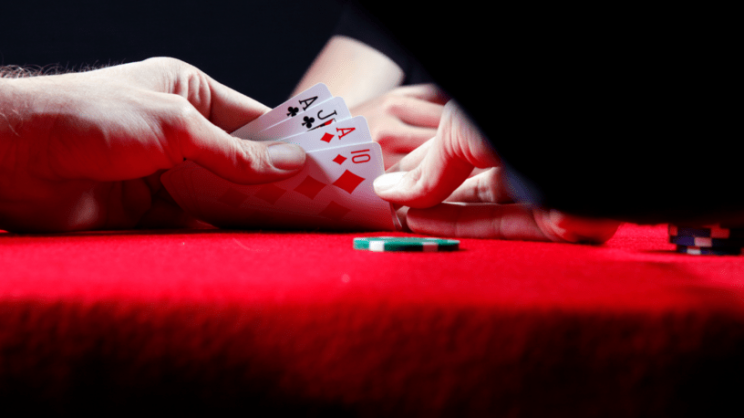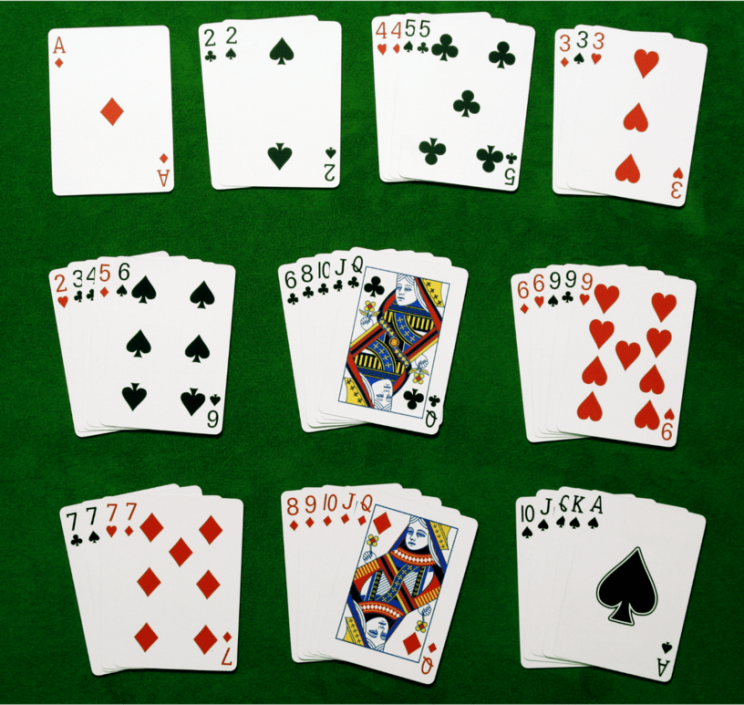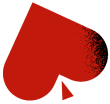
PLO奥马哈怎么玩:底池限注奥马哈扑克指南
奥马哈扑克是全球最受欢迎的扑克游戏之一,仅次于德州扑克,是第二大热门扑克变体。
随着扑克影响力的不断扩大,线上扑克的发展让更多人能够轻松参与。对于那些思维敏捷、热爱挑战并能在压力下发挥实力的人来说,扑克甚至成为了一种稳定的收入来源。
底池限注奥马哈(PLO)扑克充满刺激与变数,翻牌圈、转牌圈和河牌圈的变化让游戏充满无限可能。与德州扑克或其他扑克游戏相比,PLO 需要独特的专注力与策略,玩法大不相同。
现在,就让我们一起了解 PLO 扑克的规则、运作方式,以及如何提升胜率,让你在游戏中脱颖而出,赢得更多奖金!

如何玩奥马哈扑克
奥马哈扑克有多种变体,全部属于“公共牌扑克”游戏。在这些游戏中,玩家需要结合自己的手牌(“底牌”,仅自己可见)与场上的公共牌(所有玩家都可使用)来组成最佳牌组。
在所有奥马哈扑克版本中,玩家必须严格使用 2 张底牌 + 3 张公共牌组成最终手牌。而在德州扑克中,玩家可以自由选择使用任意数量的底牌(甚至不使用底牌)。奥马哈的这一规则让游戏变数更大,策略性更强。
最常见的奥马哈扑克变体中,每位玩家起始时会获得 4 张底牌,但只能使用其中 2 张。这使得游戏更具深度,玩家在决策时拥有更多信息。
至于“底池限注”(Pot-Limit),指的是游戏的下注限制,它极大地影响了奥马哈扑克的节奏与策略。这部分内容我们将在后面详细介绍。
基本规则就是这样!你只需要一张扑克桌、一个庄家按钮和一副 52 张标准扑克牌。如果在线上玩,比如在 Coinpoker,甚至不需要实体牌,就能立即开始 PLO 体验!
当然,最重要的是掌握游戏规则。接下来,让我们深入了解底池限注奥马哈(PLO) 的玩法和规则吧!
底池限注奥马哈规则
PLO 手牌排名
PLO 的手牌强度遵循标准扑克排名规则。从最强到最弱的牌型如下:
- 皇家同花顺(Royal Flush) – 同一花色的 5 张最大牌,例如 10♣, J♣, Q♣, K♣, A♣
- 同花顺(Straight Flush) – 5 张连续数字且同花色,例如 3♥, 4♥, 5♥, 6♥, 7♥
- 四条(Four of a Kind) – 4 张相同点数的牌,例如 9♥, 9♣, 9♠, 9♦
- 葫芦(Full House) – 3 张相同点数 + 2 张相同点数的牌,例如 10♣, 10♠, 10♦, Q♥, Q♣
- 同花(Flush) – 5 张相同花色的牌,不要求连续,例如 3♠, 6♠, 7♠, Q♠, A♠
- 顺子(Straight) – 5 张连续数字的牌,花色不限,例如 8♠, 9♠, 10♥, J♣, Q♥
- 三条(Three of a Kind) – 3 张相同点数的牌,例如 4♥, 4♦, 4♠
- 两对(Two Pair) – 2 组相同点数的对子,例如 A♠, A♣, 8♥, 8♠
- 一对(One Pair) – 2 张相同点数的牌,例如 K♠, K♥
- 高牌(High Card) – 若无玩家组成上述牌型,则比对最高单张牌。例如,手牌 3, 5, 10, Q 的玩家会胜过手牌 4, 6, 9, 10 的玩家,因为 Q 大于 10。

平手时的决胜规则
在底池限注奥马哈(PLO)及大多数扑克游戏中,当玩家出现平手时,通常会根据高牌规则来决定胜负。例如,如果两名玩家都组成顺子,则拥有顺子中最高牌的玩家获胜。例如 9-10-J-Q-K(任意花色)的顺子会击败 6-7-8-9-10(任意花色)的顺子。
当多名玩家都拥有两对时,首先比较较高的那对,点数较大者获胜。如果双方的两对完全相同,则比较踢脚牌(Kicker),即与成手牌无关的单张牌。如果踢脚牌仍相同,则依次比较第二高、第三高的牌,直到分出胜负。
实战案例分析
假设两名玩家的手牌如下:
玩家 A:K♠, 10♠, 5♥, 4♣
玩家 B:K♦, 8♣, 7♥, 4♥
公共牌:K♣, K♥, 9♦, 4♦, 2♣
两位玩家都使用自己的 K 和 4,搭配公共牌的 K♣, K♥, 4♦,组成葫芦(K K K 4 4)。由于双方的最佳牌型完全相同,因此平分底池,各自获得一半奖金。
游戏准备
每局开始时,每位玩家都会获得 4 张底牌(不向对手公开)。发牌由庄家负责,而在赌场或线上游戏中,会有专门的发牌员负责操作。但玩家仍需注意庄家位置,因为它会影响游戏顺序。
桌上会有一个庄家按钮,标示当前庄家的位置。每局结束后,庄家按钮会顺时针移动到下一位玩家,确保每位玩家轮流担任庄家。
在发牌前,庄家左侧的玩家需先下注小盲注,而再往左的玩家则需下注大盲注,其金额通常是小盲注的两倍。盲注下注完毕后,游戏正式开始!

盲注与行动顺序
下一位行动的玩家被称为“枪口位”(Under the Gun, UTG)。由于 UTG 需要最先行动,这使他处于劣势,因为所有其他玩家在翻牌前都可以根据他的决定来调整策略。
UTG 右侧的玩家是大盲注(Big Blind, BB),他是翻牌前最后一位行动的玩家。由于 BB 必须强制下注,且翻牌前没有选择权,因此这个位置也被视为不利位置。
最后一位行动的玩家被称为“按钮位”(Button, BTN),他拥有两大优势:
- 翻牌前,他是最后一位行动但不需强制下注的玩家,因此可以观察对手的行动再做决策。
- 进入翻牌圈(Flop)及后续的投注轮后,他仍然是最后一位行动的玩家,能够利用这一优势收集信息,做出更明智的决定。
在 BB 和庄家之间,还有一个小盲注(Small Blind, SB),他是翻牌前倒数第二个行动的玩家。由于 SB 需要强制下注,但在后续回合中经常处于不利位置,因此通常会损失筹码。
第一轮下注
游戏一开始就进入下注环节。每局牌(Hand)共包含四轮下注,而第一轮由枪口位率先行动。
UTG 若想继续参与游戏,至少需要跟注大盲的下注额。他会根据自己手中的四张底牌评估胜算,并决定是否下注或选择弃牌,放弃这手牌以避免损失筹码。
除了弃牌和跟注,UTG 还可以选择加注,提高当前的下注金额,迫使其他玩家跟进这个新的更高的注额,否则就无法继续游戏。这条规则适用于所有下注轮次:如果想要继续竞争,你必须至少投入与场上最高注额相等的金额。
当 UTG 行动完毕,接下来其他玩家依序选择弃牌、跟注或加注。这轮下注的结束条件是所有仍在游戏中的玩家投入相同金额,且没有人进一步加注。
需要记住的是:
- 你不能对自己已下注的金额再度加注。
- 如果所有仍在游戏的玩家都选择跟注,这轮下注结束。
- 如果有玩家加注,你可以选择再度加注(Re-Raise)。
- 如果所有对手都弃牌,只剩你一人,你立即赢得底池。
翻牌、转牌与河牌
第二轮下注开始于翻牌圈(Flop),这时三张公共牌会被亮出,放在牌桌中央,供所有玩家组合自己的最佳手牌。
从这一轮开始,由庄家左侧的第一位仍在游戏中的玩家率先行动。通常这位玩家是小盲位,但如果他在第一轮已经弃牌,那么就由下一位仍在游戏的玩家开始。
在第二轮及之后的下注轮,玩家除了可以选择弃牌、跟注或加注之外,还可以选择过牌:
- 过牌:如果没有玩家加注,你可以选择不下注,先观察其他玩家的动向。
- 但如果有人加注,你不能再过牌,必须选择弃牌、跟注或加注。
当第二轮下注结束后,第四张公共牌”转牌”会被亮出,并触发第三轮下注。
之后,最后一张公共牌”河牌”亮出,进入第四轮(最后一轮)下注。
当最后一轮下注结束后,所有仍在游戏中的玩家会进行摊牌,拥有最佳手牌的玩家赢得整个底池,获得所有下注的筹码。
加注限制
每一轮下注时,你最多可以加多少注呢?这取决于你所玩的游戏类型。例如,在无限注(No-Limit)游戏中,唯一的限制是你在桌上的筹码数量。也可以事先设定固定的注额,或者玩家可以选择玩底池限注(Pot-Limit)游戏。
在底池限注奥马哈(PLO)游戏中(以及其他任何底池限注游戏),每次加注的金额是有上限的。这个上限是跟注后,底池中的总金额。
举个例子,假设这是一场两人游戏,底池中有 50 美元。如果玩家 B 这时加注 5 美元,那么玩家 A 的最大加注额将是跟注金额加上加注后的底池总额,也就是总共 60 美元。因此,玩家 A 跟注 5 美元后,可以再加注 60 美元,这样底池就变成了 120 美元。
此时,玩家 B 可以再加注最多 180 美元,再加上他需要跟注的 60 美元,这表示玩家 B 最多可以加注 240 美元,然后游戏继续按照这个规则进行。
其他奥马哈扑克类型
五张牌奥马哈规则
五张牌奥马哈与传统的底池限注奥马哈(PLO)非常相似,唯一的不同是每位玩家会收到五张底牌。除此之外,游戏的其余部分基本相同。当然,多了一张底牌会带来更多变化、更多转折,也使得游戏更加刺激好玩。
六张牌奥马哈规则
不出所料,六张牌奥马哈和传统的 PLO 基本相同,唯一的区别是玩家手中有六张底牌而非四张。但无论是五张牌还是六张牌奥马哈,请记住,玩家依然只能使用两张底牌来组合手牌。
高低奥马哈规则
高低奥马哈(Omaha Hi-Lo)与标准奥马哈的游戏规则有很大的不同。在这种变体中,玩家仍然会获得四张底牌,并有五张公共牌来进行组合。但这次的目标是要组合出两手牌:一手高牌和一手低牌。拥有最佳高牌的玩家将与拥有最佳低牌的玩家平分底池。每手牌依然只能使用两张底牌来组合。
高牌的判定规则与标准 PLO 相同。而对于低牌的判定规则则稍微复杂一些,基本的原则是你需要组合出五张点数 8 或以下的牌。这为游戏增加了更多层次和变数,使得玩家需要思考更多策略。

奥马哈扑克策略
格外谨慎地选择起手牌
底池限注奥马哈在评估底牌的强度上可能非常棘手,尤其是对于曾经玩过德州扑克的玩家来说。有时候,你可能会觉得自己处于一个有利的位置,拥有强大的两对或三条组合的机会,但要记住,奥马哈的“强牌”标准要比德州扑克更高。
由于每位玩家手中有四张底牌,你需要意识到你的对手通常能够组合出更强的牌,因为他们有更多的变化可以利用。实际上,大多数奥马哈的获胜手牌是顺子或更强的牌,因此在选择要继续投入的手牌时,你需要格外谨慎。
时刻留意你的座位位置
更多的牌组变化意味着游戏变得更加难以预测,难以推测对手想要组成什么样的牌型。因此,任何能从位置获得的资讯都是至关重要的。
当你处于有利位置时,要准备好更频繁地加注,并通过巧妙的下注来控制底池。同时,当你处于不利位置时,尤其是在多人底池中,你需要更多地选择弃牌,避免进行冒险。
了解你的“wraps”
在奥马哈扑克中,你可以选择使用9张底牌来组成手牌,因此,顺子在这个游戏中比在德州扑克中更常见。如果你的底牌与公共牌结合形成了一个“wrap”,那通常意味着这时是一个很好的时机,可以开始进行下注。
“wrap”指当一个玩家拥有9张或更多的顺子出牌(即9张或更多的未知牌,这些牌可能会让玩家形成最佳的顺子)。举例来说,如果玩家拥有任何花色的 10、J 和 Q,而桌面上有 9 和 K,那么玩家现在只需要另外一张 10、J 或 Q 来完成顺子。牌堆中还有其他三张 10、三张 J 和三张 Q(或者其他玩家手中的牌),所以这个手牌拥有9张顺子出牌。
有这样的牌型就代表可以开始采取更积极的下注策略。
底池限注奥马哈是一个非常有趣的游戏,为玩家提供了许多刺激元素。世界各地越来越多的人对它感兴趣,如果你不仅仅是为了娱乐而玩,还想赚些钱,那么竞争就更激烈。
要战胜对手,仅仅阅读关于 PLO 扑克的资料是不够的。你必须仔细研究这个游戏,但只有通过实践,才能积累经验,学会像专业玩家一样读牌。你可以先和朋友在家里练习,或者选择在线上开始游戏。如果你选择后者,我们推荐你注册 Coinpoker,今天就开始享受精彩的在线 PLO 扑克游戏吧!


















